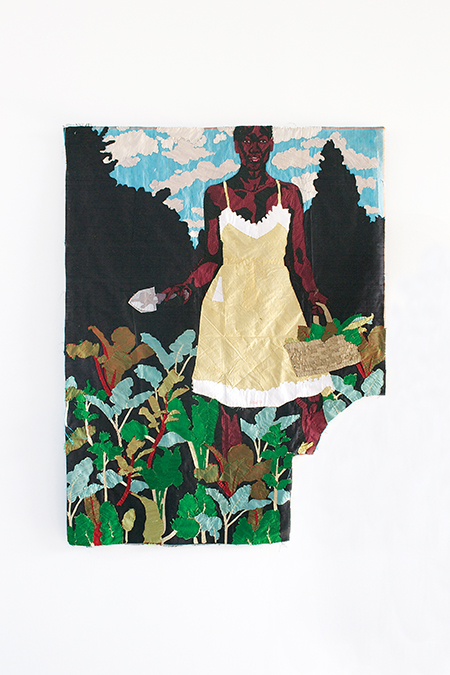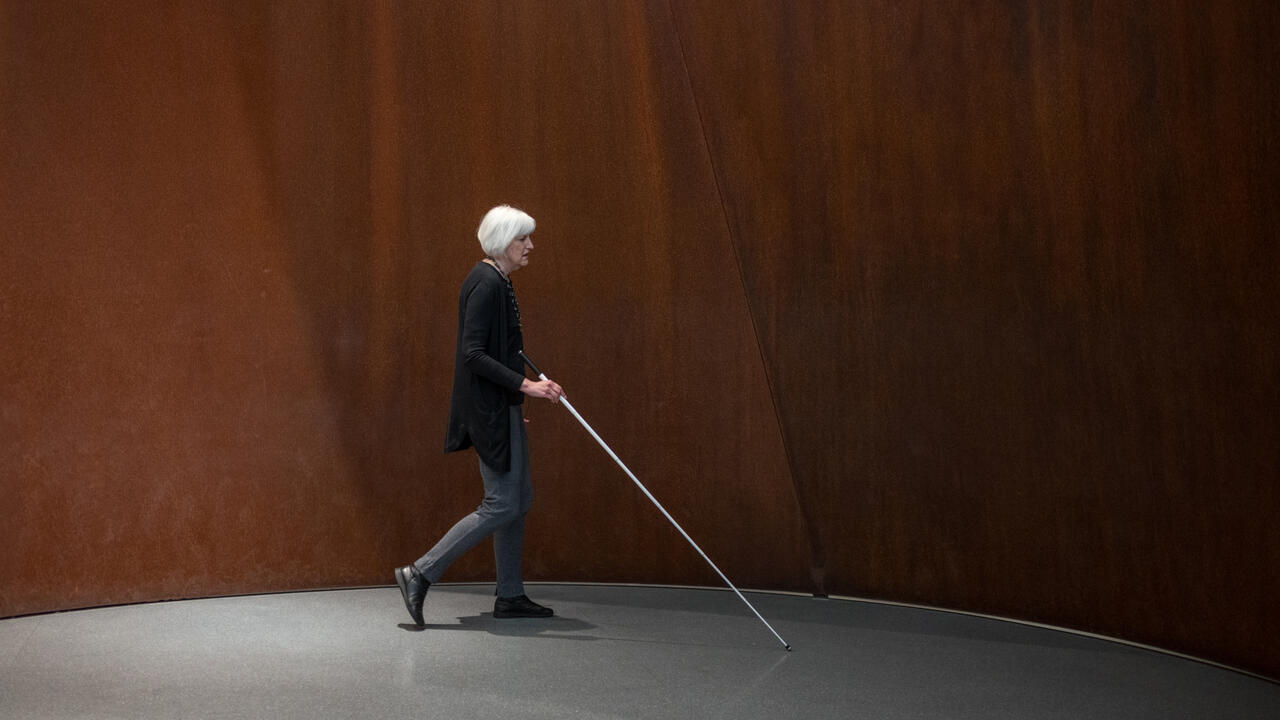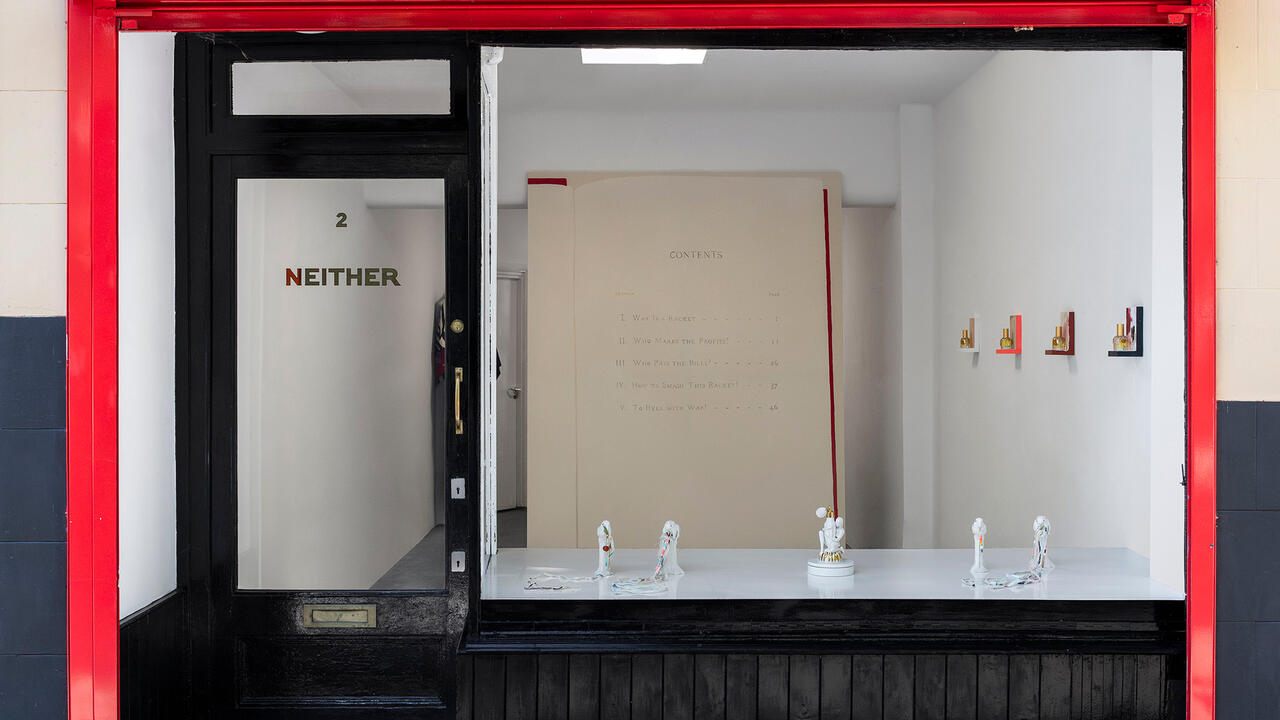Body Talk
Wiels, Brussel, Belgium
Wiels, Brussel, Belgium

‘Michael Jackson was wrong; it matters if you’re black or white.’ So says one of the dinner guests in the captivating video of French-Ivorian artist Valérie Oka’s En sa présence (In Her Presence, 2015), a meal staged during the opening of ‘Body Talk: Feminism, Sexuality and the Body in the Work of Six African Women Artists’, curated by Cameroonian-born Koyo Kouoh. For this performance, Oka invited 11 artists, theorists and historians with an interest in questions of race, sexuality and colonialism to join her for a three-course dinner discussion, set in a pool of red light cast by her neon sculpture Tu crois vraiment que parce que je suis noire je baise mieux? (Do You Really Think I’m a Better Fuck because I’m Black?, 2015). The artist co-opted the format of the genteel dinner party in order to pose the question: ‘How does the white man represent the black woman?’
In the next room, out of view of the diners, sat a vast metal cage (Oka’s Untitled, 2015), in which a naked black woman gracefully emerged from a red fabric sling and paced the floor, looking out at the audience and circumambulating a waist-high clay sculpture of an erect white penis, all the while ignoring the cage’s door, which stood ajar. This performance, captured on video and by the audience’s smartphones, explicitly recalled the ‘human zoos’ of the 19th and 20th centuries – ethnological exhibits in which the racially or physically ‘other’ was paraded as a curiosity. Oka’s work plays with the limits of permissibility and transgression in the exhibition space, pushing the audience to wonder, as did one distraught diner: ‘Do we allow this to happen because we are in the white cube, or are we revolted by it?’ This question captures the intensity of feeling that ran through the eclectic group of works presented in ‘Body Talk’. They exemplify what Kouoh identifies as ‘black feminist art’, a key characteristic of which is its deployment of the female body as a site of expression and activism. In her introduction to the show, Kouoh traces the lineage of this current trend back to the womanism of the early 1980s, an inclusive movement that compensated for feminism’s marginalization of non-white women.

The spectre of Sarah ‘Saartjie’ Baartman, known as the ‘Hottentot Venus’ – a woman who was exploited as a scientific specimen and sexual curiosity in Britain and France because of her physical features, in particular her buttocks and genitals – looms large over Oka’s caged performance. It also evokes two recent controversies around depictions of famous female bodies: Jean-Paul Goude’s Hottentot-like photographs of Kim Kardashian for Paper magazine and Beyoncé’s cover of TIME magazine, which prompted the American feminist author bell hooks to label Beyoncé a ‘terrorist’ who colludes ‘in the construction of herself as a slave’. In the latter case, the question of who actually controls depictions of the black female body and the suggestion that even powerful black women may have internalized the visual language of colonial propaganda further problematizes Oka’s works.
In 1885, King Leopold II established the Congo Free State as his personal possession, instigating Belgian colonialism and instituting a tradition of exploitation and atrocities that endures to this day. South African artist Tracey Rose’s ‘Die Wit Man’ (The White Man, 2015), a series of works dotted around the exhibition, includes a filmed pilgrimage to Leopold’s grave in the Royal Crypt at Laeken, north Brussels, in order to raise his ghost and put him on trial for his actions. The video documentation shows Rose wearing a paint-spattered poncho and a fireman’s helmet, her face painted red, black and white like a shamanic mask. She trails a totem pole made of sticks crowned with a two-faced mask, and carries a traffic cone. Through the streets of Brussels, from WIELS to Laeken via the Royal Palace, Rose calls out the names of martyred leaders into her cone and, once at Laeken, she invokes the spirit of the first democratically elected leader of the Republic of Congo, Patrice Lumumba, to judge Leopold. Rose’s amplified voice resounds throughout the gallery, haunting the space with the horrific memories of Belgian colonialism. Her helmet and cone are placed in a corner near heating pipes that she smudged with pink and beige paint to mimic Caucasian skin tones. Rose’s cosmetic adjustments of the white ‘skin’ of the gallery continues on the walls surrounding her other works, painted with ‘eggshell white’, a shade subtly different from the original white of the space.

Fracture (I) (2011–14) by Miriam Syowia Kyambi, an artist of Kenyan and German heritage, is a sprawling video installation accompanied by remnants of a performance that took place in the gallery during the opening night, in which Kyambi’s character, Rose, changes out of a traditional hand-woven sisal costume into a smart suit and make-up. Once in character, Rose stands to greet the audience, but collapses each time she attempts to walk, as if caught in a Sisyphean nightmare. Eventually, she stumbles to a platform on which she clumsily manipulates a set of wet clay pots doused in red paint.
If Kyambi’s Rose symbolizes a cultural identity caught between tradition and modernity, unable to extricate herself from the seething mess caused by colonialism, other works in the exhibition offer poised tributes to African women. New Jersey-based Nigerian artist Marcia Kure’s The Three Graces (2014) consists of abstract portraits of historic figures: the female warriors of the Kingdom of Dahõm’ey; Nandi, the mother of the 19th-century Zulu king Shaka; and Olufunmilayo Kuti, the Nigerian nationalist and mother of musician Fela. Kure’s materials include grey carpet, wood carvings resembling tribal shields and colourful afro wigs, arranged on three adjacent walls, conveying their subjects’ powerful spirits without showing their likenesses.
‘Nudes’ (2014) by Moscow-born, Morocco-based Zoulikha Bouabdellah – a series of collages in which two canonical works of European art history dovetail as the pieces in a pair of puzzles cut according to the geometric patterns of oriental carpets – alludes to the influence of Arab cultures in Africa. One of the diptychs melds Gustave Courbet’s The Sleepers(1866) with Diego Velázquez’s The Toilet of Venus (1647–51): the white limbs and lavish surroundings merge in a psychedelic interweaving of Western figuration and Moorish abstraction.
In contrast to Bouabdellah’s art-historical imagery, Billie Zangewa’s silk appliqué self-portraits, hung as the first and last works bracketing the exhibition, depict a contemporary woman whose lucid self-image appears unencumbered by pictorial stereotypes of black women. The Constant Gardener (2014) shows Zangewa, who was born in Malawi to a South African mother and Malawian father, standing in a patch of rainbow chard, dressed in a gold and white sundress and holding a trowel and a trug. The work’s lower right corner is missing, ostensibly removed and cut into smaller pieces that the artist incorporated into the image. Equally concerned with pragmatics and style, the work conveys the serenity of a woman who prefers action to activism. In The Rebirth of the Black Venus (2010) Zangewa’s likeness hovers over Johannesburg, her naked body swathed in a sash that reads ‘SURR(ender whole)HEARTEDLY (to your) COMPLEXITY’. To walk through ‘Body Talk’ was to be confronted with disparate and sometimes clashing works: the relentless stridency of Rose’s video versus Kure’s poised assemblages; the persona of Kyambi’s shambolic Rose contrasting with Bouabdellah’s cross-cultural formalist play. But this friction was a fitting embodiment of the show’s engagement with the complex history and reality of black female identity. Somewhere beyond the clamour of voices, Zangewa’s silk tapestries seemed to sublimate the intense and diverse drives in ‘Body Talk’, and to propose an affirmative – and realist – perspective on the current black feminine imaginary.






















